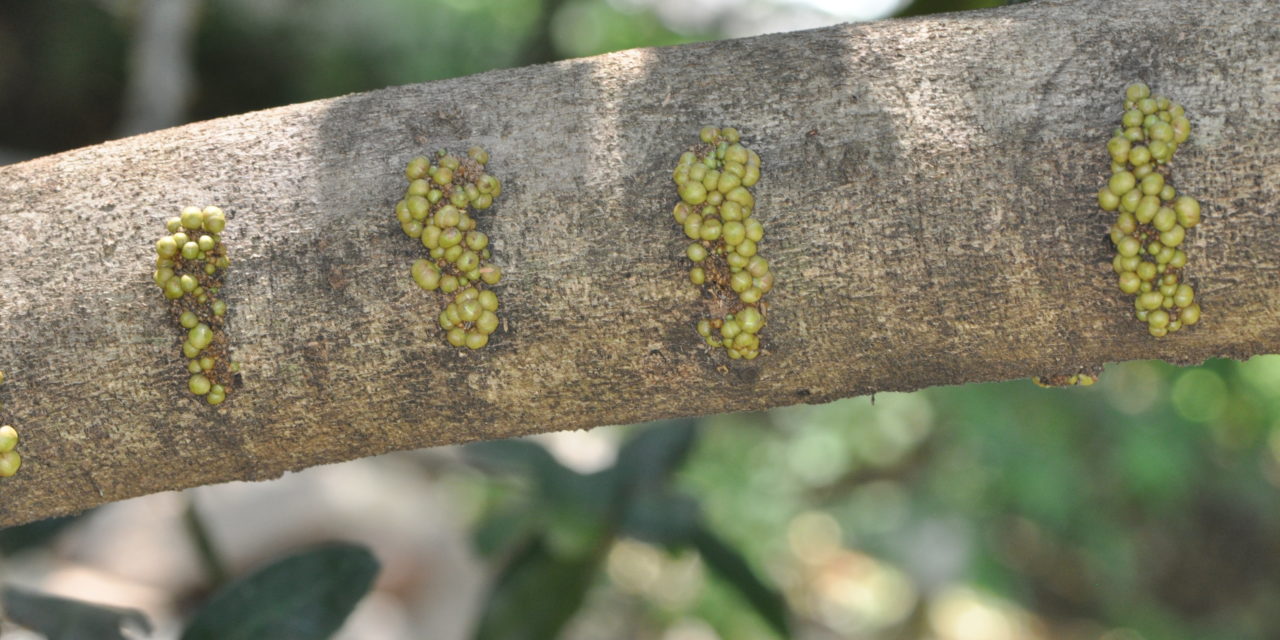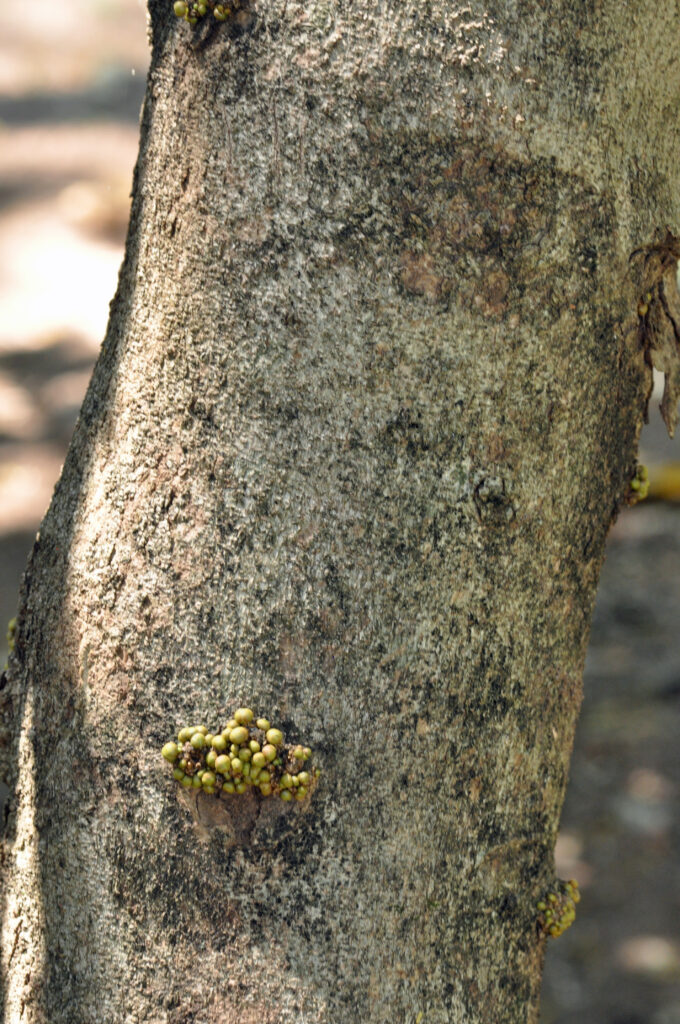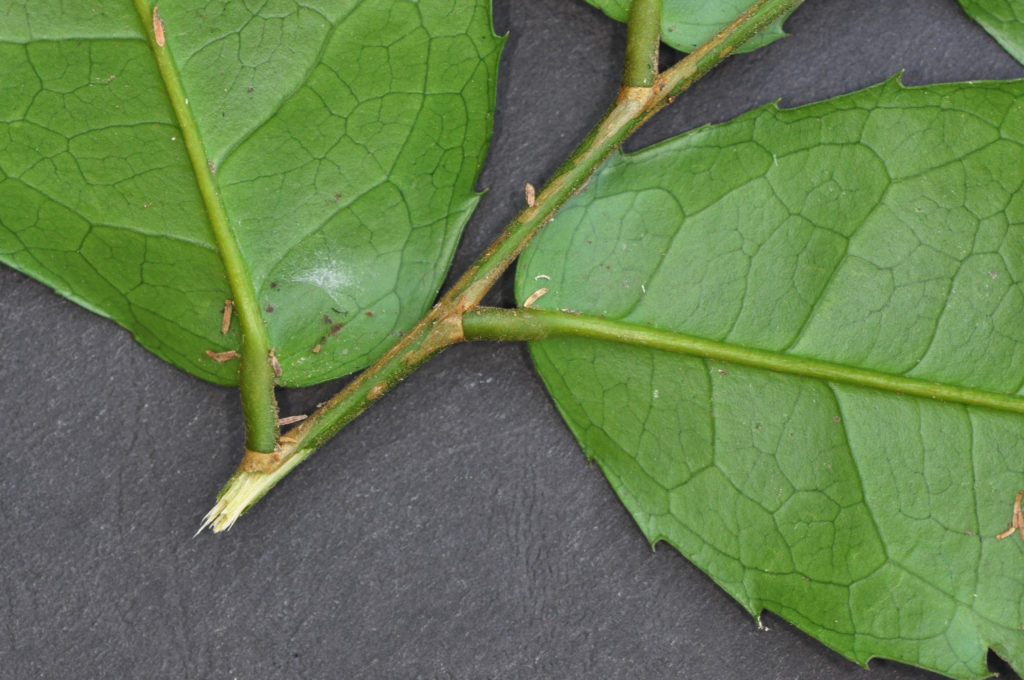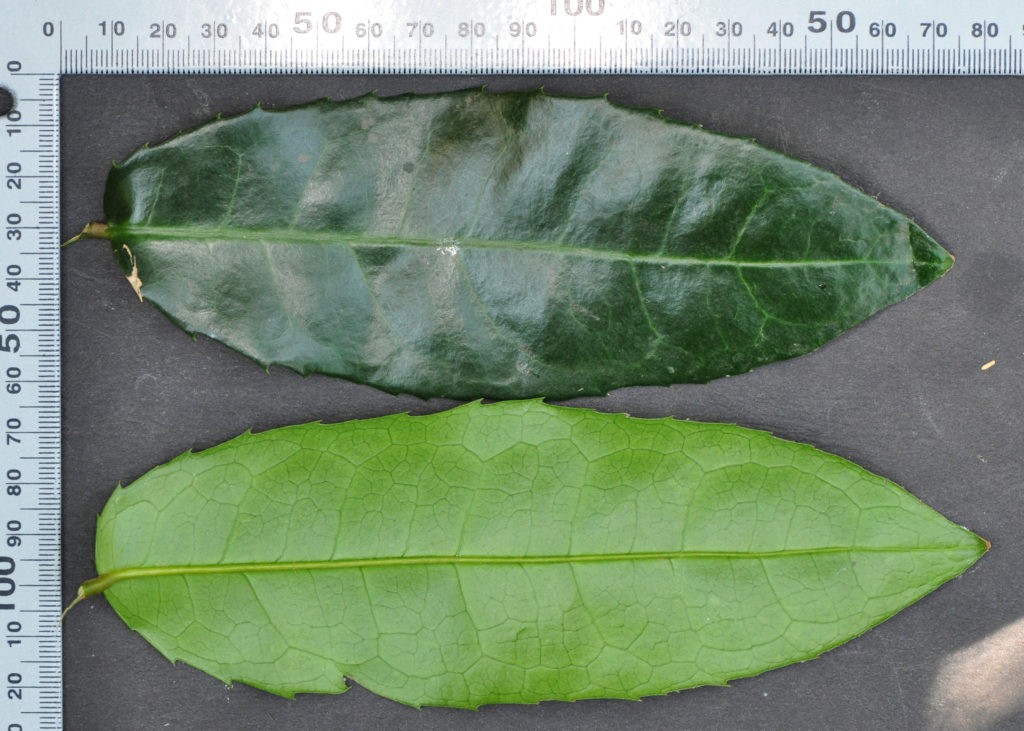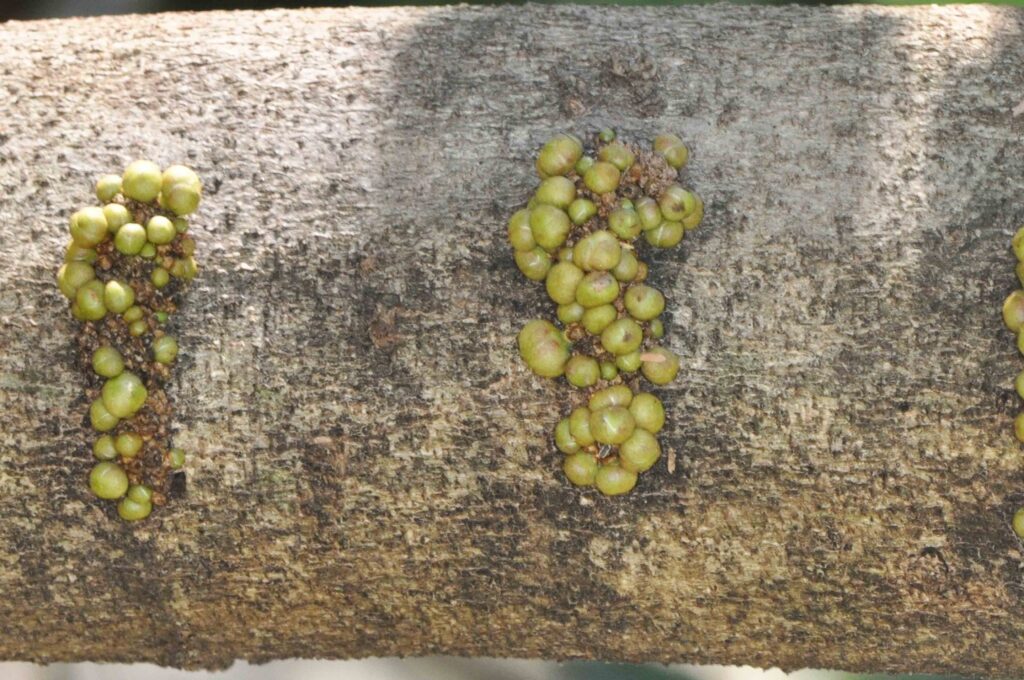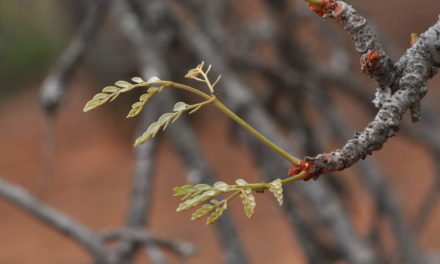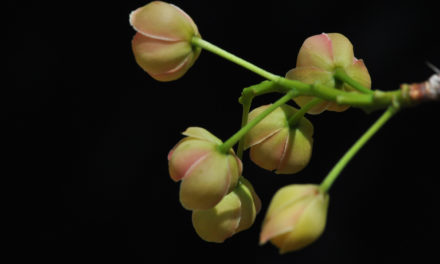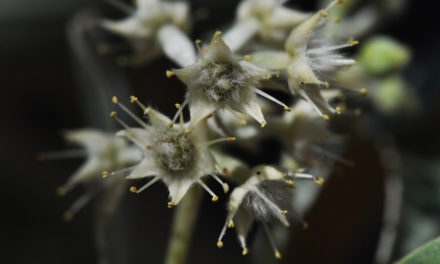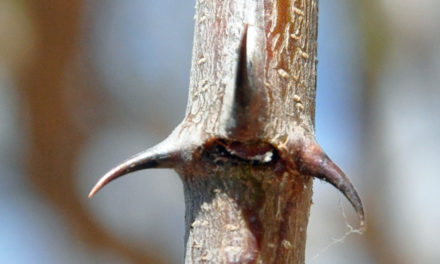General Info – summary
This dioecious Tree is up to 10m high with a 30cm wide trunk. The bark has ridges with many flowers and fruit. Large simple Leaves have an asymmetric base and spine-tipped teeth. Yellow/greenish Flowers lack petals and are cauliflorous. Male: 12 stamens, Female: superior ovary with 1-4 ovules – each with 2 locules. Stigma is short, flattened & thick. Ripe Fruit is a fleshy orange/yellow drupe + 1 seed by abortion.
Description
Drypetes natalensis var. natalensis
Previous Names: Cyclostemon natalensis.
SA Tree No. 316.
Common names: (Afr) Natal-ysterpruim, Stamvrugysterpruim. (Eng) Natal Ironplum, Stem-fruit Ironplum. (isiXhosa) Umkiwane. (isiZulu) Ikhushwane elikhulu, Umbejiza, Umgunguluza, Umgunguluzane, Umkhushwane. (Setswana) Akungulute.
Family: Putranjivaceae (was Euphorbiaceae) has 3 distinct genera containing at least 210 species. The local genera are Sibangae, Putranjiva and Drypetes. Leaves are coriaceous and 2-ranked. Young leaves are peppery due to sulphur containing chemicals. The usually small unisexual Flowers are in a condensed or in a close cluster arrangement. Fruit is a 1 seeded drupe ending in 2-3 persistent stigmas. Members of this family produce mustard oils. Brassicaceae is the only other family that does so.
Name derivation: Drypetes – ready to fall from the sky – referring to the large, heavy ripe fruit in some species. natalensis – from KwaZulu-Natal (formally Natal). The genus Drypetes has about 200 species usually in Africa and Malaysia. There are 5 species of the genus Drypetes in southern Africa. In Drypetes natalensis, only the var. natalensis occurs in South Africa.
Conservation: National Status: L C. (Least Concern). Assessed: 2005 (R.H. Archer and J.E. Victor).
Tree
This plant may be a multi-stemmed shrub or a small to medium sized Tree reaching up to 10m and occasionally 15m high. The Stem (main axis of the plant, the leaf and flower bearing as distinguished from the root-bearing axis) is up to 30cm wide. The Bark has knobbly ridges on which many flowers and fruit are borne. Otherwise, the grey trunk is relatively smooth (photo 855). Young branches are slightly angular and pubescent (with dense fine, short, soft hairs, downy) initially but becoming glabrous (hairless – photo 857 under Leaves) with age. In a mature tree, the remaining branches start above 4m. From here they spread, forming a dense rounded crown.
- 855. 2014/09/15 Lowveld NBG. Photo: David Becking.
Leaves
On this evergreen tree, the oblong, broadly lanceolate, ovate, or narrowly elliptic Leaves are stiff and leathery. Leaf size is noticeably large – up to 20 x 8,5cm and the alternate leaves are contained in the same plane (photo 857). The leathery Blade is stiff, dark green and shiny above, and a much lighter green and less shiny below. Here the venation is clearly visible, and the yellowish Midrib protrudes (photo 859). The blade usually has 7-10 pairs of Lateral veins that only protrude below and loop and loop again before reaching the Margin (photo 857). Here the stiff and widely spaced sharp, teeth (photo 857) are visible or occasionally almost absent. The Apex may be rounded or may taper – even forming a drip-tip. The Base is asymmetric (not equal to the opposite side – photo 857). One side tapers and the other is rounded. The relatively thick and strong Petiole (leaf stalk) is up to 9mm long (photo 857) and is only initially pubescent. The Stipules (basal appendages of the petiole) are linear and small – up to 4mm long. They are easily detached and fall early. Glands are absent.
- 857. 2014/09/07. Lowveld NBG. Photo David Becking
- 859. 2014/09/07 Lowveld NBG. Photo David Becking.
Flowers
The trees are dioecious (having male and female flowers on separate plants). The Flowers are produced on the trunk and older branches in fascicles (here conspicuous dense clusters of up to 100 flowers grow together). They are cauliflorous (the production of flowers and fruits directly from the branches or trunks – photo 856). This presentation is similar to stamvrug (Englerophytum magalismontanum) and the tree fuchsia Halleria lucida). They develop in small groups or are densely massed together. Against the dark trunk background, the yellowish flowers and quite distinctive. The Calyx has 4-5 overlapping Sepals – each of which is deeply concave, yellow or greenish white and up to 4 x 3,5mm. The Corolla is absent (no petals). In the strongly unpleasantly scented (for us) Male flowers, there are usually 12 Stamens with free filaments that occur in 2 whorls. Anthers are ovate (egg shaped). A concave disc (a more or less fleshy development of the receptacle) is present. The ovary is usually absent. In the Female flowers, the superior Ovary has up to 4 locules which each contain 2 Ovules. The Styles are short, and each Stigma is thick and flattened. (Sep-Nov).
- 856R. 2014/09/15 Lowveld NBG. Photo: David Becking.
Fruit
The Fruit is slightly 2 to 3-lobed (usually 3) or almost spherical. It is a nearly spherical Drupe (or stone fruit, is a fleshy, indehiscent fruit with the seed enclosed in a stony endocarp like a peach), which is small or up to 3cm wide. As it matures the colour changes from green to yellow or orange and the surface becomes velvety. The ovoid Seeds are solitary by abortion. (Dec-Mar).
Distribution & Ecology
These trees are located up the east coast of South Africa then northwards through KwaZulu-Natal to include Zimbabwe, Mozambique, Sudan, Somalia, Kenya, Tanzania and Malawi. They are found in the understory of dry evergreen dune, coastal and riverine forest, often in rocky places and semi-deciduous forest from sea level to 1 500m. These trees are less common in wetter forests. Monkeys eat the fruit.
Ethnobotany
For fruit/seeds to develop, both male and female plants are required. This is less of a problem if cuttings from male and female plants are used for propagation. The Tree is good for shade and the Fruit is edible. The Wood is used to make kitchen utensils, sticks, tool handles, building material, beds and fuel – including charcoal.
References
Archer, R.H. & Victor, J.E. 2005. Drypetes natalensis (Harv.) Hutch. var. natalensis. National Assessment: Red List of South African Plants version 2020.1. Accessed on 2023/03/28.
Boon, R. 2010. Pooley’s Trees of eastern South Africa. Flora and Fauna Publications Trust, Durban.
Burrows, J.E., Burrows, S.M., Lotter, M.C. & Schmidt, E. 2018. Trees and Shrubs Mozambique. Publishing Print Matters (Pty) Ltd. Noordhoek, Cape Town.
Coates Palgrave, M. 2002. Keith Coates Palgrave Trees of Southern Africa. edn 3. Struik, Cape Town.
Lawrence, G. H. M, 1951. Taxonomy of Vascular Plants. The Macmillan Company, New York. Tenth Printing 1965.
Palmer, E. & Pitman, N. 1972. Trees of southern Africa. Balkema, Amsterdam, Cape Town.
van Wyk, B. & van Wyk, P. 1997 Field guide to Trees of Southern Africa. Struik, Cape Town.
http://www.theplantlist.org/tpl1.1/record/kew-64978
http://www.zimbabweflora.co.zw/speciesdata/species.php?species_id=134490
http://www.prota4u.org/protav8.asp?en=1&p=Drypetes+natalensis
http://tropical.theferns.info/viewtropical.php?id=Drypetes+natalensis
http://posa.sanbi.org/flora/browse.php?src=SP

